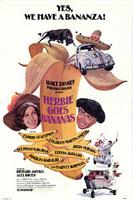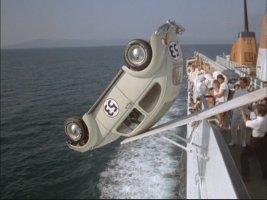Herbie Goes Bananas
 "I love your country," says Harvey Korman as Captain Blythe at one point in this automotive caper. "It's very colourful, and the children have such expressive faces."
"I love your country," says Harvey Korman as Captain Blythe at one point in this automotive caper. "It's very colourful, and the children have such expressive faces."And Disney seems to have needed no more excuse than this to set its third (and until this year's revival, Herbie: Fully Loaded, also final) sequel to The Love Bug in what becomes an increasingly dislocated Latin America.
Herbie Goes Bananas is loaded down with colour and cliché, from Inca gold to a bizarre car-as-toreador bullfight. Its leading character is the Mexican child pickpocket, Paco, whose face mostly expresses first fear as he is pursued by his various victims seeking revenge or restitution, and then joy as he is repeatedly rescued by his friend Herbie, the VW Bug with a mind of its own. And the Latin America that this road/cruise movie traverses is dislocated as any sense of geography disappears in a puff of the VW's exhaust.
But let's try to trace the film's route nonetheless. It opens in Puerto Vallarta, to which our notional heroes, DJ and Pete, have travelled by bus to pick up the old racing car, Herbie. Here Paco steals their wallet, as well as that of one of the criminal combo who are looking to unearth Inca gold. Inadvertently, Paco transfers the negatives that are somehow key to the Inca gold discovery to DJ and Pete's possession. So the bad guys are also on his trail as he stows away on a cruise ship headed down to Rio, where Herbie is to race in the Brazilian grand prix.
At sea, the car is tossed overboard for various misdemeanours committed on deck, and DJ and Pete (along with newfound companions PhD student Melissa and her lascivious Aunt Louise) are told to leave the ship when it docks en route at Panama. Herbie (whom, incidentally, Paco calls "Ocho") has meanwhile managed to swim his way to Panama also, where the various characters, including now the stranded captain Blythe, take to the road again.
Here's where the geography goes to pot. Unremarked, the Beetle and its pursuers would seem to traverse the Darien Gap by road, somehow achieving the feat despite the fact that this is where the Panamerican Highway peters out. Paco tells Blythe shortly before the bullfight scene that "Panama's long gone, capitán." Which, as they are heading south, places them already in Colombia. Not long thereafter, from the middle of the jungle, the captain tries to get a message to his ship to wait for him in Tobago, while the bad guys are busy digging up an enormous gold disk of Inca gold, and DJ informs the assembled company that they are only twelve miles from an airport in Chiclayo--which would put them in the Peruvian coastal desert. A little later, as the party are presumably drawing towards Tobago (i.e. in northeastern Venezuela), we're told that they have driven (only!) 700 miles with their car blanketed in bananas. Oh, and Herbie's powers are ascribed to (Haitian) vodú.
OK, so verisimilitude is hardly a high priority for a film whose star is a car that can think, communicate, and act on its own.
What we have is an imaginary geography that pretty much respects the map from Mexico to Panama, but that consists in an extraordinary contraction once south of the canal. In South America itself, the South Pacific, Amazonia, and the Caribbean are all essentially contiguous territories. Remains of Inca civilization can be found right next to banana plantations, the nation state and the inconvenient obstacles of border posts disappear, as also do "customs" in the sense of localizing cultural traits.
"Why are we going in circles?" asks one of the criminal gang as they try vainly to escape in a light plane. Because, well because this is a topography of affective intensity (colour and childlike expressivity) rather than geometric extension. Unlike most road movies, whose aim is to chart a territory, to mark out its boundaries and investigate the spatial coordination of its customs and cultures, Herbie Goes Bananas describes endless circles to give a dizzying sensation of "south of the border disorder."
But there's no necessary value to be attached to affective intensity. And frankly, in this instance the car should have been left at the bottom of the ocean.

